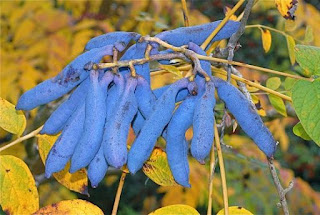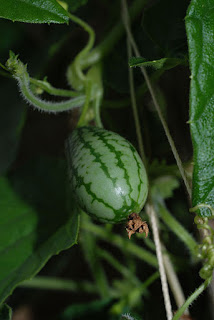James Wong's new book is now out which is something of a celebration of growing your own produce. As this is usually an exotic/tropical garden blog you may be wondering why we would be reviewing a book about growing your own food. Well the reason is simple: James' book concentrates on unusual and exotic plants for crops, many of which would make excellent choices as ornamental plants for a tropical style garden, not just on the dinner table!
The book concentrates on 80 or so of the unusual, but edible plants that James has been growing in his own garden over the last couple of years, as he has personally grown and eaten these its his own experiences that come through rather than being a re-hash of other peoples knowledge. Not only that but many of the selections in the book are plants you would not normally consider eating (dahlias, daylilies, dandelions, plus lots of plants not beginning with the letter D as well, such as cannas and even ferns).
Each plant includes a how to guide, with tips and tricks on how to grow as well as harvest and eat the plants, plus a number of more detailed recipes through out the book.
Exotic plants and exotic food in one place... that's a combination I can certainly live with!!
One of several plants that I fancy adding to the garden next year are Cucamelons (Melothria scabra), a vine from Central America, with a number of fun common names including my personal favourite, the mouse melon. Cucamelons are a little hardier than cucumbers but still should only be planted after frosts have finished. They scramble and climb for up to 2 to 3 meters, and produce plenty of the small mouse melons in the photo.
I must admit I didn't know that originally Dahlias, were first brought to the UK as a food plant, not for the large showy blooms we now know them for. They were cultivated by the Aztecs as a food plant for many years, and according to the book are still a popular food in Mexico even today. For eating them, James recommends growing the large "cactus" varieties you can get from any normal garden centre. These apparently produce much better tubers to eat. However as a word of caution, many years of breeding them for flowers has meant the taste have been neglected. Some have a Jerusalem artichoke kind of taste and others are simply "rather waters, bland and with a bitter taste".
As for eating there's a variety of ways of consuming dahlias, James suggests roasting them rather like parsnips. To be honest I think I'll stick to growing them for the flowers, but with so many other plants to try I'll give some of them a go.
As well as plants normally associated with their flowers there's also plenty of suggestions of plants more commonly eaten, such as sweet potatoes (Ipomoea batatas). We have grown these for their foliage before in the garden, and in fact there are a number of cultivars available for interesting foliage.
Another suggestion I think I will give a go next year is the Peruvian mint marigold (Tagetes minuta) which James likens the foliage to the look of marijuana (Cannabis), although I think there are a number of plants more closely resembling that particular 'weed'. However this does have a lovely form and foliage, and I think would look great in our garden next year. To eat this it can be chopped finely and use to accent the flavour of a tropical fruit salad.
Whilst the main theme of the book is about growing plants to eat I enjoyed this for the suggestions of interesting plants, many of which were new to me. Most of the plants are not just edible but also extremely ornamental, and being unusual as well would fit right into our garden. Well worth adding to your reading list even if you don't normally grow edible plants.
James Wong's Homegrown Revolution is available from all the usual book shops, but with it being the festive season we have two copies of his book to give away.
is available from all the usual book shops, but with it being the festive season we have two copies of his book to give away.
To enter simply answer the following question:
Where did James train?
a) Kew Gardens
b) New York Botanical Garden
c) Singapore Botanic Garden
Extra entries can be made by following us and sharing this competition on Twitter or by liking our page and sharing the competition on Facebook. An additional entry can be made by "following" this blog via Google Friend Connect
Terms and conditions: This competition closes at 23.59 on 15 December 2012. Any entries received after this time will not be counted. Entrants must be UK residents aged 18 years or older to enter. By entering this competition you agree and consent to your name being published and by taking part in the competition, entrants are deemed to have read, understood and accepted all of the Terms and Conditions and agreed to be bound by them. The winner will be selected at random from the correct entries and will be announced here on the blog. Please make sure we are able to contact you if you do win, as we will need to arrange for your prize to be sent to you.
 |
| Decaisnea fargesii, we have grown this for a number of years but never considered eating it |
Each plant includes a how to guide, with tips and tricks on how to grow as well as harvest and eat the plants, plus a number of more detailed recipes through out the book.
Exotic plants and exotic food in one place... that's a combination I can certainly live with!!
 |
| Cucamelons (Melothria scabra) |
I must admit I didn't know that originally Dahlias, were first brought to the UK as a food plant, not for the large showy blooms we now know them for. They were cultivated by the Aztecs as a food plant for many years, and according to the book are still a popular food in Mexico even today. For eating them, James recommends growing the large "cactus" varieties you can get from any normal garden centre. These apparently produce much better tubers to eat. However as a word of caution, many years of breeding them for flowers has meant the taste have been neglected. Some have a Jerusalem artichoke kind of taste and others are simply "rather waters, bland and with a bitter taste".
As for eating there's a variety of ways of consuming dahlias, James suggests roasting them rather like parsnips. To be honest I think I'll stick to growing them for the flowers, but with so many other plants to try I'll give some of them a go.
As well as plants normally associated with their flowers there's also plenty of suggestions of plants more commonly eaten, such as sweet potatoes (Ipomoea batatas). We have grown these for their foliage before in the garden, and in fact there are a number of cultivars available for interesting foliage.
Another suggestion I think I will give a go next year is the Peruvian mint marigold (Tagetes minuta) which James likens the foliage to the look of marijuana (Cannabis), although I think there are a number of plants more closely resembling that particular 'weed'. However this does have a lovely form and foliage, and I think would look great in our garden next year. To eat this it can be chopped finely and use to accent the flavour of a tropical fruit salad.
 |
| Tagetes minuta (image from Wikipedia) |
James Wong's Homegrown Revolution
To enter simply answer the following question:
Where did James train?
a) Kew Gardens
b) New York Botanical Garden
c) Singapore Botanic Garden
Extra entries can be made by following us and sharing this competition on Twitter or by liking our page and sharing the competition on Facebook. An additional entry can be made by "following" this blog via Google Friend Connect
Terms and conditions: This competition closes at 23.59 on 15 December 2012. Any entries received after this time will not be counted. Entrants must be UK residents aged 18 years or older to enter. By entering this competition you agree and consent to your name being published and by taking part in the competition, entrants are deemed to have read, understood and accepted all of the Terms and Conditions and agreed to be bound by them. The winner will be selected at random from the correct entries and will be announced here on the blog. Please make sure we are able to contact you if you do win, as we will need to arrange for your prize to be sent to you.


 This gardening blog follows our journey as we create our Tropical and Exotic themed garden. We hope you'll enjoy the journey as much as we do. We started our Exotic Garden in 2005 and this site will show its development, as well as our travels, both abroad and within the UK to gardens, nurseries and friends.
This gardening blog follows our journey as we create our Tropical and Exotic themed garden. We hope you'll enjoy the journey as much as we do. We started our Exotic Garden in 2005 and this site will show its development, as well as our travels, both abroad and within the UK to gardens, nurseries and friends.














Sounds like a really cool book! I, too, think that I will stick to dahlias as ornamentals, though.
ReplyDeleteOh, and he trained at Kew Gardens... :)
Hi College Gardener, we're curious now about Dahlia tubers, we might just give it a try....:)
DeleteWhat a great concept for a book, taking that whole front yard food thing and turning it exotic. And now of course "cucamelon" is going to be in my head all day long. Did he say how they taste?
ReplyDeleteIt's a catchy name isn't it, Cucamelon :) He says it tastes of cucumber and lime, seems a refreshing combination. I'm actually really looking forward to growing this one in particular next year, especially as this plant seems very ornamental too. And flicking through the book, I've spotted even more new plants that's I'm curious trying. Roll on spring!
Deletea) Kew Gardens
ReplyDeletekew gardens
ReplyDeleteThe answer is A) Kew Gardens
ReplyDeleteKew Gardens
ReplyDeleteThe answer is A) Kew Gardens
ReplyDeleteBook looks good, but more pics of James Wong please!
ReplyDeleteI'll try Martin, will send him a message :)
DeleteThose Cucamelons are very cute (if a little strange!).
ReplyDeletePlease enter me into the prize draw - the answer is Kew Gardens!
Aren't they just lovely! Strange and unusual is perfect for our garden! and it will be nice to have a few more things in the garden to eat too.
DeleteAnswer: Kew Gardens
ReplyDeleteKew gardens @ollieamelia
ReplyDeleteKew Gardens
ReplyDeleteKew Gardens
ReplyDeleteGreat blog post! I say a) Kew Gardens :)
ReplyDeleteThanks Sarah :)
DeleteKew
ReplyDeleteThe answer is a) Kew Gardens. Have just returned this book to the local library but would love to have a permanent copy on my bookshelf. Cucamelons are already on my seed list to try out at the allotment next
ReplyDeleteyear :) Tagetes minuta appeals too - it is rumoured to be effective as a weed eradicator.
Hi Anna, Cucamelons work on so many different ways, the look cool, sound cool and probably tast cool too! Where did you get your seed from?
DeleteKew Gardens
ReplyDeletea) Kew Gardens
ReplyDeleteKew Gardens
ReplyDeleteKew Gardens.
ReplyDeleteKew Gardens
ReplyDeletea) Kew Gardens
ReplyDeleteKew Gardens
ReplyDeleteKew Gardens is the answer, but the book will be in this house win or lose, love the thought of a colourful edible garden
ReplyDeleteAnswer - Kew Gardens :)
ReplyDeletekew gardens :)
ReplyDelete@sarahrees151286
Kew gardens
ReplyDeleteA) Kew Gardens
ReplyDeletea) Kew Gardens
ReplyDeletea) Kew Gardens
ReplyDeletea) Kew Gardens
ReplyDeleteanswer a.kew gardens
ReplyDeletea) Kew Gardens
ReplyDeleteHi! The answer is A) Kew Gardens and I have followed on twitter @highrising51 :)
ReplyDeletea) Kew Gardens - I loved watching his program on the TV :) Glad to see the book, would make a great read!
ReplyDeletea) Kew Gardens would love to try the Cucamelons
ReplyDeletea) Kew Gardens
ReplyDeletea) Kew Gardens
ReplyDeletea) Kew Gardens
ReplyDeleteGood heavens, see what happens when you offer a really interesting book in a competition?! I love the sound of cucamelons. I'd been toying with the idea of getting hold of a copy of this, I think you have swayed me, though I'd rather win a copy from you! He trained at Kew Gardens (a).I'll have to look in to Tagestes minuta, beautiful foliage, but like you will stick to growing Dahlias for their flowers. I have a spot lined up in the front garden for "After Eight", which is entirely your fault. Well, and Liz@Gwirrel's Garden, who also grows it...
ReplyDeleteA) kew garden
ReplyDeleteA) Kew Gardens. :) :D xx good luck to everyone xx
ReplyDeleteFollowed and shared on twitter - @MorningPostie
ReplyDeleteFollowing on GFC - Mickie Bull
ReplyDeletea) Kew Gardens
ReplyDeletea) Kew Gardens
ReplyDeleteA) Kew Gardens
ReplyDeletea) Kew Gardens
ReplyDeletekew
ReplyDeletea) Kew Gardens
ReplyDeleteKew Gardens
ReplyDeleteKew Gardens
ReplyDeleteKew Gardens x
ReplyDeleteA) Kew Gardens
ReplyDeleteKEW GARDENS
ReplyDeleteKew Gardens
ReplyDeletea) Kew Gardens
ReplyDeletea) Kew Gardens
ReplyDeletea) Kew Gardens
ReplyDeleteAnswer a Kew Gardens
ReplyDeletea) Kew gardens
ReplyDelete[email protected]
a) Kew Gardens
ReplyDeletea) Kew Gardens
ReplyDeleteAnswer: Kew Gardens.
ReplyDeleteWow those Cucamelons sound great will have to give them a try, my toddler eats cucumbers all day long so i'm sure she'll be a fan as well.
a) Kew Gardens
ReplyDeletea) Kew Gardens
ReplyDeleteKew Gardens
ReplyDeleteA) Kew Gardens
ReplyDeletea) Kew Gardens
ReplyDeleteKew Gardens
ReplyDeletea) Kew Gardens
ReplyDeleteA) Kew Gardens. Sue [email protected]
ReplyDeletea) Kew Gardens
ReplyDeletekew gardens
ReplyDeletea) kew gardens
ReplyDeletea) Kew Gardens
ReplyDeletea) Kew Gardens
ReplyDeleteKew Gardens
ReplyDeleteAnswer: a) Kew Gardens. Love James Wong's TV and books. Think we tried just about everything from Grow Your Own Drugs.
ReplyDeletea) Kew Gardens
ReplyDeleteKew Gardens
ReplyDeletea) Kew Gardens
ReplyDeletea) Kew Gardens
ReplyDeleteKew Gardens
ReplyDeletea kew gardens
ReplyDeleteAnswer: a) Kew Gardens
ReplyDeletea) Kew Gardens
ReplyDeleteKew Gardens
ReplyDeletea) Kew Gardens
ReplyDelete[email protected]
James trained at Kew Gardens
ReplyDeleteJames trained at Kew Gardens
ReplyDeleteA) Kew Gardens
ReplyDeleteA) Kew Gardens
ReplyDeletea) Kew Gardens
ReplyDeleteJames trained at Kew Gardens, this is a lovely book my step father would love it!
ReplyDeleteA) Kew Gardens
ReplyDeleteKew Gardens
ReplyDeleteKew gardens xxx
ReplyDeletea)Kew Gardens
ReplyDeleteI like on Facebook and have shared - Kirsty Fox
ReplyDeleteJames trained at kew Gardens
ReplyDeletekew Gardens
ReplyDeletea) Kew Gardens
ReplyDeletea) Kew Gardens
ReplyDeleteKew Gardens
ReplyDeleteThis looks great. He trained at Kew Gardens.
ReplyDeleteKew Gardens I believe
ReplyDeleteI have followed and tweeted - @snarepuss
ReplyDeleteI have liked and shared :)
ReplyDelete